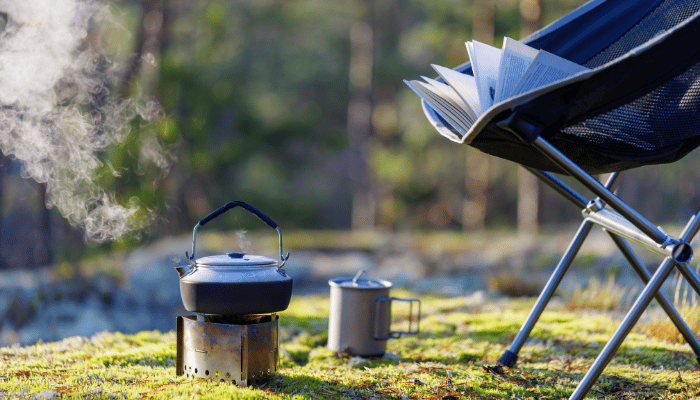
Tips on how to become a gear tester with Dan Nelson, Gear Institute editor and long-time member of the Outdoor Writers Association of America.
Sitting inside a leaky tent, wrapped in a bag seemingly stuffed with turkey quills rather than goose down, I had an epiphany: Gear testing really is work.
It was the mid-1990s and I had a contract to review “budget gear” for Backpacker magazine. The criteria I developed required testing five to six products in each of the big four categories: Tents, packs, sleeping bags, and boots. And none could cost more than $100 — I think boots had a $50 limit. There were a few gems among the budget gear, but most proved unworthy of even the pittance of being asked by the manufacturer. I spent a few months covering hundreds of trail miles, frequently in sheer agony. Sore feet on the trail from cheap boots. Aching shoulders from poorly designed packs. Cold, wet nights in camp thanks to shoddy tent and sleeping bag construction.
But at the end of the season, I got my name on four sizeable story packages that shared some solid information. I received a decent-sized check, and I realized that as much as I loved being outside, sometimes being there was little more than a pain-in-the-ass job.
But not all gear testing involves misery.
Testing prototypes
I’ve also been blessed with the opportunity to use and review innumerable products long before the public ever saw them. I’ve used prototypes that proved too expensive to bring to market, and influenced the final design of more than a few best selling pieces of gear. All in all, my 27+ years as a gear reviewer has been a blast.
Path to gear testing
My path to being a professional gear tester took a few side trails but generally I followed some well-established tracks to success as an outdoor journalist. I started working as an outdoor writer in 1990 freelancing outdoor columns for the Tacoma News Tribune. At the time, I worked full-time as a general news reporter for the paper’s little sister, the Pierce County Herald. In 1992 I went to work for a non-profit, the Washington Trails Association, and helped create a new monthly magazine out of an old club newsletter. At the same time I convinced the editors of Backpacker to give me a shot at writing for them. At first I provided northwest hiking coverage, but when the editors there learned I was out on trails three to four days a week, they hired me to start testing gear. I soon started writing hiking guidebooks for Mountaineers Books, and that furthered my reputation as a professional backpacker and outdoor gear expert.
My first gear review ran in 1992, and from that day on, I worked to include gear coverage in most of my freelance editorial packages. I didn’t do that with a goal of becoming a gear review specialist — I did it because it was a unique angle on a common story pitch. USA Today bought a feature on hiking Mount Rainier’s Wonderland Trail in part because I included a sidebar on the latest generation of gear designed to make the 94-mile hike pleasant. When Outside agreed to a feature on the 15th anniversary of Mount St. Helen’s eruption, my volcano-friendly gear recommendations sidebar was the final selling point. When the Seattle Times came calling about a regular column, they got a “Get in Gear” weekly feature that ran for 15 years.
Six tips to become a professional gear tester
Many of my gear-reviewing colleagues tell similar stories, and the path to professional gear reviewing seems to include a few well established steps.
Pitch, pitch, pitch
Pitch yourself and your work to any and all possible markets. Write reviews of the gear you’ve bought and include those in your pitches as examples of your work. Maybe start a personal gear blog so you can show an ongoing body of work.
Be realistic with pay for your gear review
Don’t expect big payoffs, especially early on, but don’t be discouraged. Keep pitching, keep writing and make sure you are honestly able to bill yourself as an expert in your field.
Stay honest and objective in your gear reviews
Be fair, honest and objective in all reviews. As a gear tester,you are working for the readers, not the gear makers. I’ve panned some $1,000 ski jackets, and praised $40 boots. If you suck up to gear makers to stay in their good graces, you’ll turn off your readers — and your editors.
Be creative in the field when testing gear
If you can’t get out into the backcountry to thoroughly use a product, or if conditions don’t provide for thorough testing,improvise. I’ve set up a bunch of tents in a field and blasted them with rain-bird sprinklers for 12-24 hours to simulate pounding rainstorms.
Find your niche for gear testing
Find a niche and become an expert. For me, that was hiking and backpacking. My time working with Washington Trails Association and as a hiking guidebook author established my gravitas as a professional hiker.
Have fun when your testing gear
Have fun. At the end of the day, if you don’t enjoy what you are doing, that’s going to be reflected in your work.
Dan Nelson is the editor of GearInstitute.com and long-time member of the Outdoor Writers Association of America. He’s always looking for gear experts with serious writing chops. If you are an expert in a product category that you think might work for his site, give him a shout at dan.nelson@gearinstitute.com.
Did you find this article helpful? If yes, an Outdoor Writers Association of America (OWAA) membership may be right for you. There are a myriad of individual membership benefits — including our robust member magazine, Outdoors Unlimited that features helpful articles geared toward outdoor media and our annual in-person conference coming up in Gulf Shores, Alabama, September 9-11, 2022.
